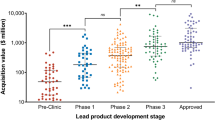Abstract
This chapter examines the applicability of real options in improving the robustness of the research and development (R&D) continuity of biotech start-ups during the valley of deficits or against the systemic risk as the financial crisis, because they have to endure more than 10 years to get an approval of a medicine on the market subject to the resource constrains, if they could raise enough financial resources. The organization of this chapter is consists of four sections excluding introduction and conclusion. The first section mentions an analysis on the present investment environment for R&D continuity of biotech start-ups. The second section examines the existing basic theories on the decision-reserving functions of real options. The third section attempts to figure out the flexibility value of a sequential compound switching option that is designed to select the optimal mode between an assumed drug development process as benchmark and a cooperative development in strategic partnership on the way. The fourth section is trying to map the selective decisions made at the market and cooperative development risks (or potential) based on these data. Moreover, its aim is to support decision making by creating 3-D graphs between the net present value (NPV) and both risks and also among these indices with market volatility.
Access this chapter
Tax calculation will be finalised at checkout
Purchases are for personal use only
Similar content being viewed by others
References
Black F, Scholes M (1973) The pricing of options and corporate liabilities. J Polit Econ 81:637–659
Burrill & Company (2011) Biotech 2011. San Francisco, CA
Carr P (1988) The valuation of sequential exchange opportunities. J Finance 43:1235–1256
Copeland TE, Antikarov V (2001). Real options: a practitioner’s guide. Texere, New York
Cox J, Ross S, Rubinstein M (1979) Option pricing: a simplified approach. J Financial Econ 7:229–263
Dixit A (1989) Entry and exit decisions under uncertainty. J Polit Econ 97:620–638
Dixit AK, Pindyck RS (1994) Investment under uncertainty. Princeton University Press, Princeton
Fujiwara T (2008a) Japan’s health-care service quality and the death-valley strategy of biotech start-ups. Glob J Flex Syst Manage 9:1–10
Fujiwara T (2008b) Modeling of strategic partnership of biotechnological start-up by option-game: aiming at optimization between flexibility and commitment. J Adv Manage Res 5:28–45
Fujiwara T (2011) Application of timing option to founding investment decision of biotech start-ups. J Bus Chem 8:133–146
Geske R (1979) The valuation of compound options. J Financial Econ 7:63–81
Kester WC (1984) Today’s options for tomorrow’s growth. Harv Bus Rev 62:153–160.
Kulatilaka N, Marcus A (1992) Project valuation under uncertainty: when does DCF fail? J Appl Corp Finance 5:92–100
McDonald R, Siegel D (1986). The value of waiting to invest. Quart J Econ 101:707–728
Majd S, Pindyck R (1987) Time to build, option value, and investment decisions. J Financial Econ 18:7–27
Margrabe W (1978) The value of an option to exchange one asset for another. J Finance 33:177–186
Merton RC (1973) Theory of rational option pricing. Bell J Econ Manage Sci 4:707–727
Mun J (2006) Modeling risk. Wiley, Hoboken
Myers SC (1977) Determinant of corporate borrowing. J Financial Econ 5:147–176
Online Wall Street Journal (2009) http://online.wsj.com/public/ page/news. Accessed September 2009
Pharma Japan Web (2013) http://pj.jiho.jp/servlet/pjh/organization/outline/1226565564647.html. Accessed October 2013
Roberts K, Weitzman ML (1981) Funding criteria for research, development and exploration projects. Econometrica 49:1261–1288
Smith RL, Smith JK (2004) Entrepreneurial finance (2nd ed.). Wiley, Hoboken
Trigeorgis L (1996) Real options: management flexibility and strategy in resource allocation. MIT Press, Cambridge
Trigeorgis L, Mason SP (1987) Valuing managerial flexibility. Midland Corp Finance J 5:14–21
Author information
Authors and Affiliations
Corresponding author
Editor information
Editors and Affiliations
Appendix
Appendix
At Dixit model of business entry or exit under risk modeled as random work of value behavior as geometric Brownian motion, respective trigger price derived of business entry and exit is (Dixit 1989):
Thus, it can be explained that if volatility is at a risk scale of \(\sigma \to 0\), each fraction of α and β approaches 1, then a fraction consisted of risk interest rate ρ and growth rate μ works enough, on the other hand, if \(\sigma>0\), each function of fraction α and β expands, then it amplifies the deferment function.
Rights and permissions
Copyright information
© 2016 Springer India
About this chapter
Cite this chapter
Fujiwara, T. (2016). Research and Development (R&D) Continuity of Biotech Start-ups in Financial Crisis. In: Sushil, ., Bhal, K., Singh, S. (eds) Managing Flexibility. Flexible Systems Management. Springer, New Delhi. https://doi.org/10.1007/978-81-322-2380-1_15
Download citation
DOI: https://doi.org/10.1007/978-81-322-2380-1_15
Published:
Publisher Name: Springer, New Delhi
Print ISBN: 978-81-322-2379-5
Online ISBN: 978-81-322-2380-1
eBook Packages: Business and ManagementBusiness and Management (R0)




